
The containership market in
2001
|
|
|
| |
After a booming
year 2000, the container ship charter market is in the doldrums. The
terrorist attacks of 11th September have cast a chill on a market
already cold. To make matters worse, liner operators are receiving huge
newbuildings, which are currently unwanted.
|
| The
freight market |
|
Ships are running under their capacity.
Charter rates have plummeted, as well as box rates. Capacity cuts and even
lay-ups have been proposed. The shifting of ships to North-South trades
through domino effect is also seen as a way of absorbing East-West
capacity, although a tricky one. For example, ships of 3,000 to 4,000 teu
found their way on the already congested Europe-Middle East-India trade,
depressing the rates further on this route.
|
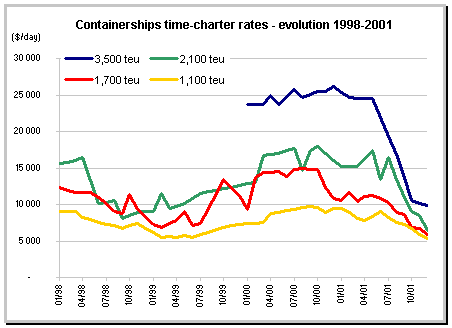
|
|
|
In what is qualified a "synchronised
sinking" of economies, the world industrial production has shrunk. In
South East Asia, emerging economies are linked more than ever before to
the US economy, especially in the field of technology goods. They became
over-dependent on exports to recover from the 1997 crisis, the consequence
of a weak domestic demand. There are however exceptions: China and India
perform better than their neighbours.
What matters for liner operators are the trade figures. In the first
half of 2001, the U.S. imports have decreased by 12.5 % on an annual basis
while the Taiwan, Japan or Singapore exports fell by 25 %. The number of
ships idle (spot) rose strongly in the 1,000 to 2,500 teu range during the
first half of 2001. In the second half of the year, several ships of 2,500
to 4,000 teu were left idle at the end of their charter. And when these
large ships find employment, it is at depressed rates. Conversely, smaller
ships of 500 to 1,200 teu have remained in strong demand for feeder or
short-sea and mid-sea trades. Their rates have decreased, but they have
not plunged.
Quite remarkably, the difference in charter rates between small and
large ships has shrunk considerably, as already seen in previous
depressions. At the end of 2001, ships of 500 teu got $4,500 per day,
while ships of 3,000 / 3,500 teu could not expect more than $10,000.
The capacity monitoring schemes implemented in the fourth quarter on
the Europe-Far East and on the Transpacific trades led to more pain. Many
operators are embarrassed by the large ships they received throughout the
year. These schemes made it possible to trim the East-West capacity in an
unprecedented way in the containership era.
One thing is clear: owners of vessels dedicated to the charter market
support the brunt of the capacity cuts. Not only do they see some of their
ships idle at the end of their charters (especially the large ones), but
they have suffered from a dramatic fall in charter rates. Charter rates
for large ships have halved since their peak of the Summer 2000.
All is not negative however. The downfall in box rates has its positive
side as lower rates allow the carriage in containers of low priced
commodities, or neo-bulk cargoes commonly carried on cargo vessels or bulk
carriers. The drawback is that these cargoes are mainly heavy ones, but
huge quantities of bagged rice, some steel products such as small pipes or
steel wire, aluminium coils, forest products' can also be containerised.
Seeing that some of these cargoes are currently carried by over-aged cargo
vessels, which are to disappear in the coming two years or so with the
2002 enforcement of the International Safety Management (ISM) code for
general cargo vessels, we believe that there is a card to play for
containerships. Once in the box, such cargoes could be retained by
containership operators, as far as rates remain attractive enough. Very
Large Container Ships (VLCS) would help to capture these cargoes in case
of a market recovery, although if rates are really booming it would make
sense to cast longing glances at more rewarding cargoes.
It should not be forgotten that in the medium-term, the new capacity
now coming on the market will be absorbed. Orders will have to flow again.
Recent history has shown that seaborne container transportation has always
grown more quickly than international trade as a whole. However, there is
comparatively less growth expected than in the past, when a lot of
break-bulk trades had yet to be containerised. International trade itself
grew at twice the growth rate of the world economy in the past two
decades. Assuming an annual growth of 7 % in container trades, the fleet
needed in 2010 will be twice as big as the 2000 one. Nevertheless, it
remains to be proved whether this rule of thumb is to be repeated in the
future.
|
The
operators
|
|
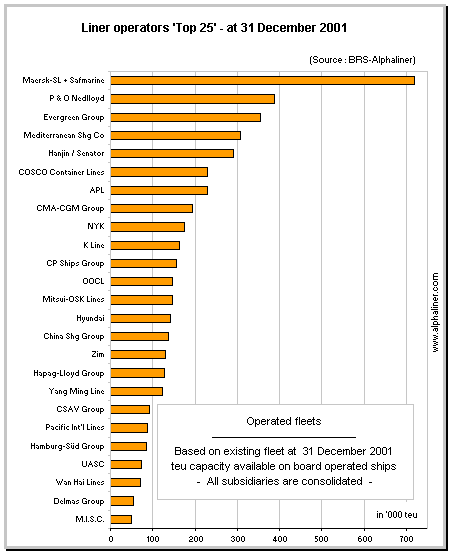
|
|
The liner shipping industry is not as concentrated
as other industrial sectors. It is scattered among some 300 operating groups
employing 4,650 ships deployed on liner trades worldwide and representing 6.3
million teu in December 2001, of which 150,000 teu were inactive as a result of
the market slow-down, according to BRS-Alphaliner data. Nineteen of them are
involved in the East-West trades (Transatlantic, Transpacific, Asia-Europe).
The largest of them, Maersk-SeaLand operates a capacity of 725,000 teu,
representing 11.8 % of the global active capacity in teu terms. The next in
size is P&O Nedlloyd, with 6.2 % of the global capacity.
|
|
There have been only minor transactions since
the buying of Norasia Lines by CSAV in June 2000. The most significant one
has been the takeover of ACL by Grimaldi. Other small transactions took
place, such as the last bits of Harrison going to P&O-Nedlloyd, the
buying of Fred Olsen Canary service by OPDR and the buying of the Kent
Line container business by Tropical Shipping.
Now that the pressure is on, mergers and acquisitions will surely be
given a new impetus. The gloom has already claimed its first large victim
as Choyang collapsed. After a meteoric rise, China Shipping -once a
prominent player on the charter market- has paused. The floating of C.P.
Ships and the proposed one for P&O-Nedlloyd, transform these operators
into targets for some of the major players, who could then turn into
"super mega carriers".
CMA-CGM was one of the most aggressive operators in 2001, with the
launching of several services, especially to South America and Africa. The
company also took delivery in 2001 of the bulk of its newbuilding program,
which includes among others a series of eight 6,700 teu ships, replacing
4,000 teu ones on the Asia-Europe route.
In order to fill them, CMA-CGM followed a clever strategy of concluding
agreements with possible competitors, inviting them to buy slots on its
ships, without binding itself into rigid and more or less global
agreements. Not only is this solution satisfying for the company, but it
also appears as a boon to operators which do not have the volume to
justify deploying their own ships. Contship and Lykes have entered the
Asia-Europe trade this way. Furthermore, they benefit from economies of
scale allowed by very large ships.
|
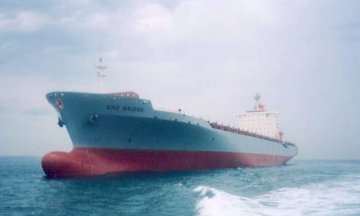 |
Mare Phoenicium (ex-EMS Bridge)
4,038 teu, btl 1999 by Hyundai, owned by Hansa Mare Reederei GmbH & Co., under her previous name, now chartered by CMA-CGM for their MedTPX service |
|
| The
fleet
|
|
The cellular fleet has doubled during the past
seven years, in teu terms. At 31 December 2001, there were 2,914 cellular
ships over 100 teu, aggregating 5.53 million teu, while the orderbook
reached 436 ships for 1.45 million teu, down from a peak of 1.65 million
teu in early 2001. At 31 December 2001, there were 164 ships over 5,000
teu in service, and a further 95 on order. The largest ships in service
remain the 15 'Sovereign' class series vessels of Maersk-SeaLand, the
capacity of which stands at around 8,000 teu.
|
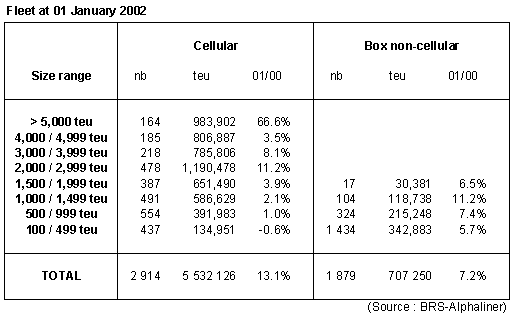
|
The good news is that new orders have waned.
In the second half of 2001, only four ships of 5,000 teu and over have
been ordered. However, after 665,000 teu delivered in 2001, there are
still 740,000 teu due for delivery in 2002 and 450,000 teu in 2003.
|
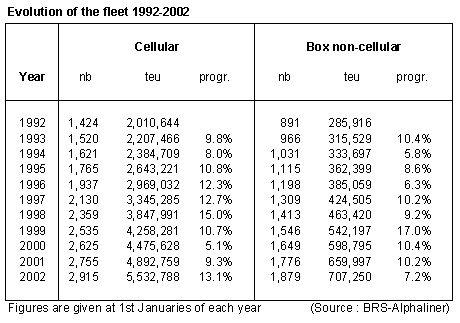
|
|

|
|
As for cellular ships deleted from the commercial scene (either broken
up or converted to military or other use), their capacity aggregates
around 45,000 teu in 2001. This represents a small fraction of the 665,000
teu delivered this same year.
The advent of the ULCS: inroads into the
future |
Plans to order container-ships of 9,000 teu and over have been put on
hold, but the current gloom will have an end as international trade will
continue to grow. With this in view, ULCS (Ultra Large Container Ship of
12,000 to 14,000 teu) is a viable option, at least for the largest
carriers.
It would not be surprising to see the first of such ships sailing by
the middle of the decade. Maersk-SeaLand is the best placed in the race
for the coming two or three years: most of its key hubs will be fitted
with eight or nine 22-row cranes, able to serve 55 or 56 metres-wide
ships, with lengths which could reach 410 m to remain compatible with
stability requirements (i.e. ships of 14,000 teu).
There is a consensus which has emerged, saying that the 9,000 teu ship,
and more surely the 12,000+ teu ship, is a perilous adventure. For the
18-row 9,000 teu ships, there are already plenty of terminals which can
handle them. They are in fact not much bigger than Maersk-SeaLand's 'S'
class (with an estimated real intake of 7,960 teu at six tiers on deck).
The main problem is to fill them on a high volume route, while keeping
other options on parallel routes in order to offer a sufficient number of
direct links and, hence, competitive transit times between a number of
ports.
Surely it is a perilous affair for the 12,000 teu ship (and even for
smaller ships of 22 row breadth), as these ships will rely solely on a
given route because so few ports will be adequately equipped to handle
them, at least in the beginning. Such an argument is nothing new. In the
late 60's, it was often said that containerisation would remain an
East-West affair for the very same reasons. The conservative companies
specialising in North-South trades at that time and sticking to this idea
are no longer there.
Given the volumes concerned on routes such as Asia-Europe or
Transpacific, individual operators would find it difficult to venture into
this kind of project (Maersk-SeaLand set aside). A grouping of lines
within a tight consortium would be needed in order to share the financial
burden and ensure the viable long-term operation of high volume strings
with ULCS (and not a mere technical "alliance", which is no more
than a slot swapping arrangement).
Such a concept sends us back 30 or 35 years, when rival operators had
to regroup in what were then called "integrated consortiums" in
order to replace armadas of general cargo vessels with a handful of large,
costly containerships on key routes. In such consortiums, day to day
receipts and expenses were fully pooled, with a joint managing entity.
Alas, such consortiums are today outdated and the pioneers such as Trio
or ScanDutch are now history. In a world where things are prone to change
overnight, tight agreements are not the recommended way. Only a new wave
of mergers and acquisitions could make the ULCS option a reality in the
medium-term.
High volumes carried on inter hub "container pipe-lines"
justify the advent of ULCS. Such pipe-lines will come on top of parallel
direct services, including shuttles linking two or three ports. They
complement container pipe-lines between key regional ports, on the
East-West traditional routes as well as the North-South ones.
After all, the pattern of North-South routes has become the same as on
East-West routes, only the average size of ships makes the difference.
Whatever the cargo and the route are, the transport units are the same: 20
and 40-feet boxes (put aside specialist equipment such as reefers), and
they are handled by the same standardised terminals. The accompanying
tariff-making process is made easier by the expansion of the "Freight
All Kinds" approach.
Such an evolution will also lead to the "commoditisation" (a
neologism) of container transport. In other terms, the transport of a
container from point A to point B (including inland destinations) could be
traded as a commodity, thus clearing the ground for the setting up of a
futures market, with shippers hedging against variations of box rates. In
such a world, the carrier with the lowest cost regarding other logistics
input, such as transit times and reliability of service, will win the
game.
VLCS and ULCS will surely play their role in this equation. Yield
management, i.e. the best possible use of the available capacity (as
already applied in the passenger airline industry), will also continue to
develop. With all this in mind and with very large ships coming, allowing
economies of scale as yet unseen, there is little doubt that the nature of
the competition is to change in the current decade.
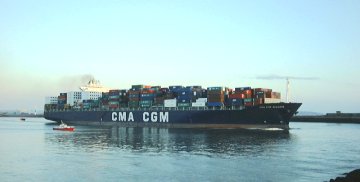 |
CMA CGM Berlioz
6,477 teu, blt 2001 by Hanjin, operated by CMA CGM |
|
Shipping and Shipbuilding Markets in 2001
I N D E X
|